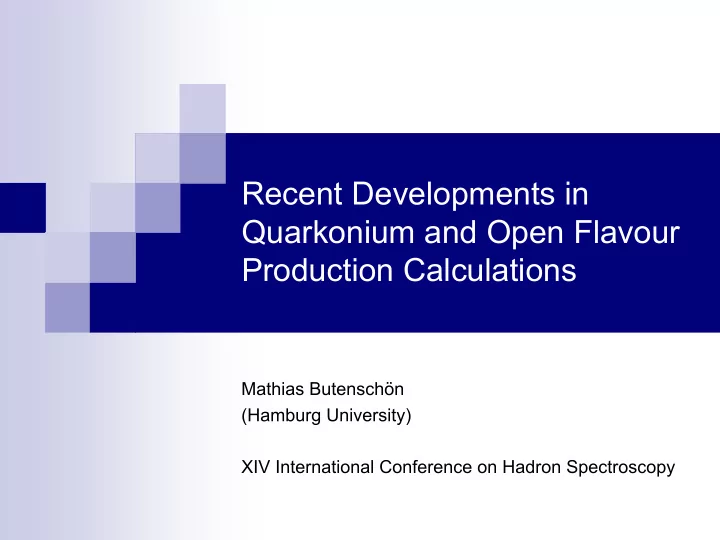

Recent Developments in Quarkonium and Open Flavour Production Calculations Mathias Butenschön (Hamburg University) XIV International Conference on Hadron Spectroscopy
Production and decay rates of Heavy Quarkonia Heavy Quarkonia: Bound states of heavy quark and antiquark. Charmonia ( cc ̅ ) and Bottomonia ( bb ̅ ) Top decays to fast for bound state. The classic approach: Color-singlet model Calculate cross section for heavy quark pair in physical (=color neutral) state. In case of J/ ψ : cc ̅ [ 3 S 1 color singlet [1] ] Multiply by quarkonium wave function (or its derivative) at origin Mid 90’s: Strong disagreement with Tevatron data apparent Nonrelativistic QCD (NRQCD): Rigorous effective field theory: Bodwin, Braaten, Lepage (1995) Based on factorization of soft and hard scales (Scale hierarchy: Mv 2 , Mv << Λ QCD << M ) Could explain hadroproduction at Tevatron M. Butenschön Recent developments in quarkonium and open flavour production calculations 1/20
J/ ψ Production with NRQCD Factorization theorem: n : Every possible Fock state, including color-octet states. : Production rate of cc ̅ [ n ], calculated in perturbative QCD σ cc ̅ [ n ] <O J/ ψ [ n ] > : Long distance matrix elements (LDMEs): describe cc ̅ [ n ] ➙ J/ ψ , universal, extracted from experiment. ≈ Scaling rules : LDMEs scale with definite power of v ( v 2 0.2): v 3 v 7 v 11 scaling n 3 S 1 1 S 0 [8] , 3 S 1 [8] , 3 P J ... [1] [8] and α s Double expansion in v Leading term in v ( n = 3 S 1 [1] ) equals color-singlet model . M. Butenschön Recent developments in quarkonium and open flavour production calculations 2/20
J/ ψ Production with NRQCD: Knowledge until 2005 Hadroproduction Photoproduction γγ Scattering at Tevatron: at HERA: at LEP: e + e − → e + e − J/ ψ X at LEP2 NRQCD d σ ( γ p → J/ ψ X)/dz (nb) 10 ZEUS (38 pb -1 ) ← DELPHI prelim. _ → J/ ψ +X)/dp T (nb/GeV) [ 8 ] BR(J/ ψ→µ + µ - ) d σ (pp 3 P J H1 (80 pb -1 ) (scaled) [ 1 ] 3 P J ← MRST98 fit 10 2 H1 (80 pb -1 ) high W √ s =1.8 TeV; |η| < 0.6 ← [ 8 ] 1 S 0 CTEQ5 fit ← 1 10 total ⎯ S = 197 GeV √ colour-octet 1 S 0 + 3 P J colour-octet 3 S 1 2 (pb/GeV 2 ) − 2 < y J/ ψ < 2 NRQCD LO colour-singlet colour-singlet frag. -1 10 50 < W < 180 GeV 1 p T > 1 GeV d σ /dp T 10 -2 KZSZ (LO, CS+CO) 10 -1 10 KZSZ (NLO, CS) 0.117 < α s (M Z ) < 0.121 [ 8 ] 1.3 < m c < 1.6 GeV 3 S 1 ← -3 CSM 10 -2 5 10 15 20 10 1 p T (GeV) 0 1 2 3 4 5 6 7 8 9 10 0 0.2 0.4 0.6 0.8 z 2 (GeV 2 ) p T CO LDMEs extracted from Born fit to Tevatron (one linear combination). Used for predictions at HERA and LEP. No NLO calculations for color-octet (CO) contributions yet! Universality of CO LDMEs open question. M. Butenschön Recent developments in quarkonium and open flavour production calculations 3/20
NLO Corrections to Color Octet Contributions Petrelli, Cacciari, Greco, Maltoni, Mangano (1998): Photo- and hadroproduction (Only 2 → 1 processes) Klasen, Kniehl, Mihaila, Steinhauser (2005): γγ scattering at LEP (neglecting resolved photons) M.B., Kniehl (2009): Photoproduction at HERA (neglecting resolved photons) Zhang, Ma, Wang, Chao (2009): e + e − scattering at B factories Ma, Wang, Chao (2010): Hadroproduction (including feed-down contributions) M.B., Kniehl (2010): Hadroproduction (combined HERA-Tevatron fit) Necessary: A rigorous global data analysis! Only recently: Fit CO LDMEs to 194 data points from 10 experiments. Test LDME universality. [M.B., Kniehl (2011)] M. Butenschön Recent developments in quarkonium and open flavour production calculations 4/20
Recommend
More recommend